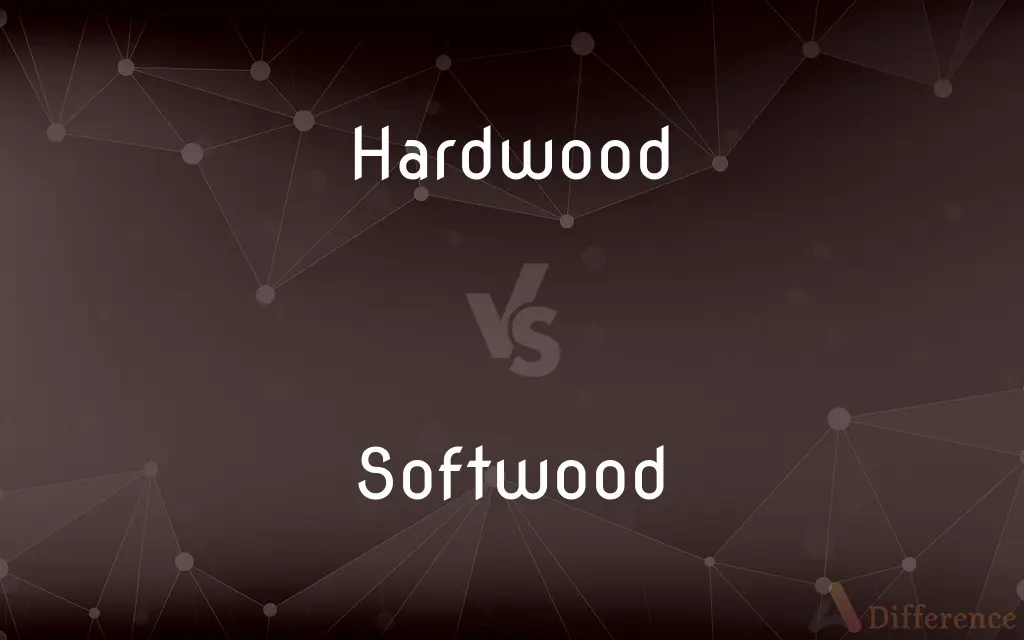Hardwood vs. Softwood — What's the Difference?
By Tayyaba Rehman & Urooj Arif — Updated on March 24, 2024
Hardwood comes from deciduous trees that lose their leaves annually, known for density and durability, while softwood comes from coniferous trees, often lighter and used for varied applications.

Difference Between Hardwood and Softwood
Table of Contents
ADVERTISEMENT
Key Differences
Hardwood is derived from deciduous trees that shed their leaves annually, offering a wide range of colors and grain patterns. This type of wood is generally more durable and resistant to wear, making it preferred for furniture and flooring. Softwood, on the other hand, comes from coniferous trees that retain their needles year-round, and it tends to be lighter and less expensive, which makes it popular for construction, especially framing and outdoor structures.
The growth rate of hardwood trees is slower compared to softwood trees, leading to denser and harder wood. This slow growth contributes to the higher cost of hardwood. Whereas softwood trees grow faster, resulting in a more plentiful and affordable supply. This makes softwood a cost-effective choice for many large-scale projects.
In terms of appearance, hardwoods offer a wide variety of textures, colors, and grain patterns, appealing for decorative purposes and high-quality furniture. Softwoods, while generally more uniform in appearance, can still provide a beautiful natural look, especially when treated or finished appropriately.
Hardwoods are often used in high-traffic areas and in products that require durability, such as flooring, decks, and high-quality furniture. Softwoods, on the other hand, are frequently used in construction, especially for framing, as well as in the production of paper and cardboard due to their softer fibers.
Environmental sustainability is a concern for both types of wood, but there are sustainable practices in place for both hardwood and softwood harvesting. Hardwoods, because of their slower growth, require more careful management to ensure sustainability, whereas softwoods, being more rapidly renewable, are often seen as more environmentally friendly options when sourced responsibly.
ADVERTISEMENT
Comparison Chart
Source
Deciduous trees
Coniferous trees
Density
Generally higher
Generally lower
Growth Rate
Slower
Faster
Cost
Generally more expensive
Generally less expensive
Common Uses
Furniture, flooring, decks
Construction framing, paper
Grain & Color
Varied textures and colors
More uniform appearance
Durability
Higher, suitable for high-traffic areas
Lower, but suitable for many applications
Environmental Impact
Requires careful management for sustainability
More rapidly renewable, often seen as more environmentally friendly
Compare with Definitions
Hardwood
Requires careful harvesting for sustainability.
Sustainable hardwood sourcing is crucial for environmental conservation.
Softwood
Wood from coniferous trees, widely used in construction.
The house's frame was constructed with softwood.
Hardwood
More expensive due to slower growth rates.
Hardwood products are considered an investment due to their cost.
Softwood
Lighter and less expensive than hardwood.
They chose softwood for the project to stay within budget.
Hardwood
Dense and heavy wood, ideal for furniture.
The dining set was made of solid hardwood.
Softwood
Often chosen for its ease of use and workability.
Softwood is preferred for DIY projects due to its workability.
Hardwood
Varied in color and grain, popular for aesthetics.
Hardwood varieties like oak and maple are prized for their beauty.
Softwood
Commonly used for paper production.
Softwood pulp is a primary material for paper goods.
Hardwood
Wood from deciduous trees, often used for its durability.
The hardwood floor remained pristine for decades.
Softwood
Faster growth rates make it more abundant.
Softwood trees replenish quickly, making them readily available.
Hardwood
Hardwood is wood from dicot trees. These are usually found in broad-leaved temperate and tropical forests.
Softwood
Softwood is wood from gymnosperm trees such as conifers. The term is opposed to hardwood, which is the wood from angiosperm trees.
Hardwood
The wood of a eudicot or a magnoliid, such as an oak, maple, or magnolia.
Softwood
The wood of a coniferous tree.
Hardwood
A eudicot or magnoliid tree.
Softwood
A coniferous tree.
Hardwood
The wood from any dicotyledonous tree, without regard to its hardness.
Balsa is a hardwood, but a soft hardwood.
Softwood
The wood from any gymnosperm, without regard to how soft this wood is.
SYP is a softwood, but it is harder than many hardwoods.
Hardwood
(countable) (in more general use) As the preceding, but limited to those that are commercial timbers, and are at least average in hardness.
Ash, hickory and oak are some of the most prominent domestic hardwoods.
Softwood
Wood of this kind, but limited to those that are commercial timbers.
Hardwood
The tree or tree species that yields the preceding.
This hardwood has been planted extensively throughout the hills here.
Softwood
The tree or tree species that yields this wood.
This softwood has been planted extensively throughout Scotland.
Hardwood
(uncountable) A joint term for the commercial timbers, without distinguishing which.
You should have used hardwood for this window sill instead of this junk.
Softwood
(uncountable) Any commercial timber.
You should have used softwood for the frame of this shed, instead of overbuilding it like this.
Hardwood
The sport of basketball, in particular, an indoor basketball court; so named because the floor of an indoor basketball court is normally made of hardwood.
Softwood
Wood that is easy to saw (from conifers such as pine or fir)
Hardwood
(of a floor) Made of interlocking hardwood boards.
Softwood
Made of the easy-to-cut wood of a coniferous tree, as e.g. pine;
Softwood lumber
Hardwood
The wood of broad-leaved dicotyledonous trees (as distinguished from the wood of conifers); also items made from such wood; as, decorative hardwood.
Hardwood
Made of the hard-to-cut wood of a broad-leaved tree, as e.g. oak; consisting of a hardwood; as, hardwood floors; - of wood and wooden objects.
Hardwood
The wood of broad-leaved dicotyledonous trees (as distinguished from the wood of conifers)
Hardwood
Made of the hard-to-cut wood of a broad-leaved tree, as e.g. oak;
Hardwood floors
Common Curiosities
Can softwood be used for furniture?
Yes, softwood can be used for furniture, especially when cost or specific aesthetic qualities are considerations.
Is hardwood always better than softwood?
Not necessarily; the choice between hardwood and softwood depends on the specific requirements of the project, including durability, cost, and aesthetics.
Why is hardwood generally more expensive than softwood?
Its slower growth rate makes it denser and more durable, contributing to a higher cost.
What are common uses of softwood?
Construction framing, paper production, and outdoor structures.
How do the physical characteristics of hardwood and softwood differ?
Hardwood is generally denser and has a variety of colors and grains, while softwood is lighter and more uniform in appearance.
What are common uses of hardwood?
Furniture, flooring, and high-traffic area applications.
Can softwood be as durable as hardwood?
Softwood can be treated or finished to enhance its durability, but it naturally tends to be less durable than hardwood.
What is hardwood?
Wood from deciduous trees, known for its density and durability.
What is softwood?
Wood from coniferous trees, often lighter and used in various applications.
Are there sustainable options for hardwood and softwood?
Yes, there are sustainable practices and certifications in place for both, aiming to minimize environmental impact.
What makes hardwood suitable for flooring?
Its density and durability make it capable of withstanding high traffic without significant wear.
What considerations should be taken into account when choosing between hardwood and softwood?
Considerations include the project's durability requirements, budget, aesthetic preferences, and environmental impact.
Why might someone choose softwood over hardwood for a project?
Cost, availability, and the specific physical properties required for the project might make softwood a more suitable choice.
Is softwood environmentally friendly?
When sourced responsibly, softwood, due to its faster growth and renewable qualities, is considered environmentally friendly.
How does the appearance of hardwood and softwood compare?
Hardwood offers a wide range of colors and grain patterns, while softwood generally has a more uniform appearance.
Share Your Discovery

Previous Comparison
Tilt vs. Skew
Next Comparison
Leave vs. LiveAuthor Spotlight
Written by
Tayyaba RehmanTayyaba Rehman is a distinguished writer, currently serving as a primary contributor to askdifference.com. As a researcher in semantics and etymology, Tayyaba's passion for the complexity of languages and their distinctions has found a perfect home on the platform. Tayyaba delves into the intricacies of language, distinguishing between commonly confused words and phrases, thereby providing clarity for readers worldwide.
Co-written by
Urooj ArifUrooj is a skilled content writer at Ask Difference, known for her exceptional ability to simplify complex topics into engaging and informative content. With a passion for research and a flair for clear, concise writing, she consistently delivers articles that resonate with our diverse audience.














































